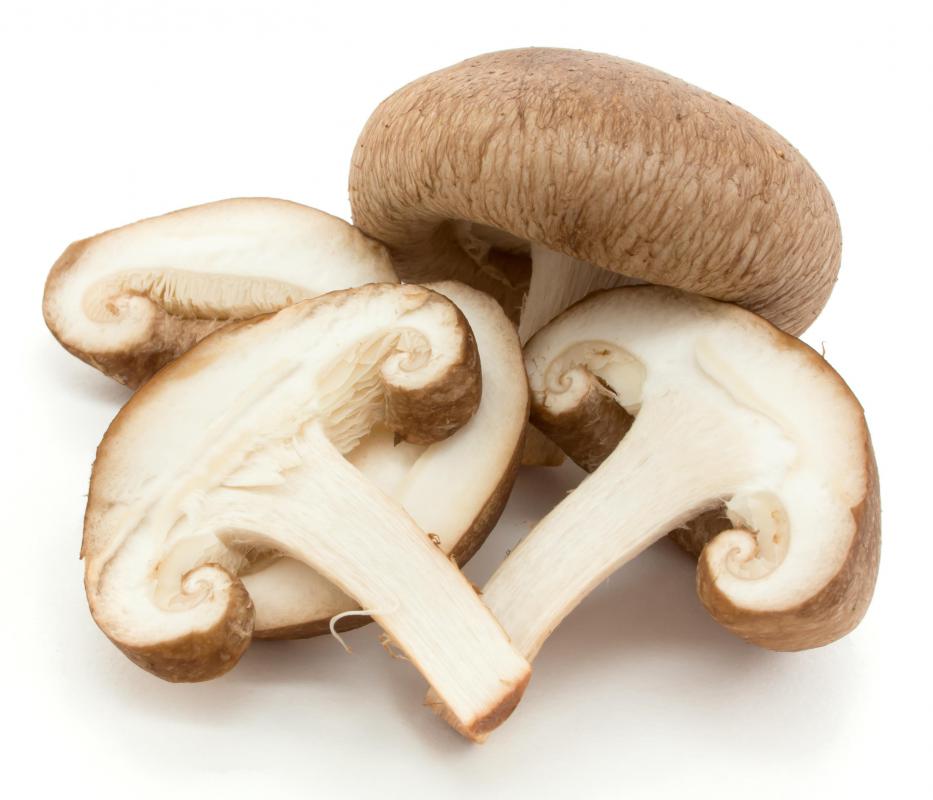At DelightedCooking, we're committed to delivering accurate, trustworthy information. Our expert-authored content is rigorously fact-checked and sourced from credible authorities. Discover how we uphold the highest standards in providing you with reliable knowledge.
What is Umami?
Umami is a distinct, difficult to describe flavor caused by the interaction of glutamates, a naturally occurring amino acid, with receptors on the tongue. Some people call it “the fifth taste,” as it is distinctly not sweet, sour, bitter, or salty, but is instead sometimes called savory. In addition to having a unique standalone flavor, umami appears to enhance foods it is combined with, making other flavors richer and more intense. The concept is ancient, although the official term is relatively recent.
Every time someone puts ketchup on fries, they are using the principle of umami. Both potatoes and tomatoes have high amounts of free glutamates, which interact with each other to create a distinctive flavor. Other foods with an abundance of free glutamates include seafood, shiitake mushrooms, meats, carrots, and seaweed, among many others. Many of these foods have been traditionally paired to enhance their natural flavor.

The discovery of umami is credited to Kikunae Ikeda, a researcher at Tokyo Imperial University. Ikeda was researching the unique flavor of seaweed broth when he isolated a distinctive compound that he identified as savory, since it did not fit with the other four identified tastes. Ultimately, he managed to separate a unique white powder with a crystalline structure, which came to be known as monosodium glutamate, or MSG. Ikeda's discovery paved the way to many developments in food science and to a restructuring in the way people though about taste.

In addition to modern day examples, the flavor has also been harnessed historically. It appears in high concentration in cured and fermented foods, such as the Roman garum and an assortment of traditionally fermented Asian sauces such as soy sauce and fish sauce. This flavor has classically been used as a condiment, to enhance the flavor in other foods, bringing out their natural savory taste.

There has been some controversy over this flavor. Some people believe that it is not, in fact, a distinct flavor, and wish that it was not classified as the fifth taste. Others have historically had concerns about glutamates, and MSG in particular, claiming that the compounds have deleterious health effects. Especially in the West, the concept was not as readily adopted as it was in Asia, as is reflected by the lack of an English word for the taste. Western chefs have slowly embraced the concept, however, designing dishes which harness the power of umami, whether it is truly a distinct taste or simply a subset of another.
AS FEATURED ON:
AS FEATURED ON:














Discussion Comments
Umami has nothing to do with MSG. Umami is an overall flavor in combination with the four testable flavors we can perceive with our taste buds, when sweet, salty, sour and bitter are combined at a certain level.
There are no proven scientific allergies to MSG, but overuse can cause headaches and muscle aches as it is a type of salt. Our bodies make MSG naturally and it is found in large amounts in tomatoes.
Umami experiment
Sweet: Mix 1 cup water and 2 teaspoons of sugar. Set aside
Salty: Mix 1cup water and 1 teaspoon of salt. Set aside
Sour: Mix 1 cup water and 1/2teaspoon cream of tartar. Set aside
Bitter: 1/2 teaspoon unsweetened cocoa powder. Do mix with water.
Umami: 1 cup water mixed with 1 teaspoon dried Shitake Mushroom ( boil and let cool)
Taste each, one at a time. Tinse between tastings.
Then mix a little of the umami to each one and taste again.
This should round out the sour and bitterness and increase the sweet and saltiness. You just discovered the umami effect. it has nothing to do with MSG.
Here's an intriguing tidbit. Recently I was gifted with a chocolate bark with listed ingredients of cacao and cane sugar. Tasting notes: Black truffle, Umami and Mild Oak finish. This information is what led me to this site. Hmm. Is Umami a new taste buzzword? I'm not keen on ingesting MSG.
@anon132540: Citric acid is a naturally occurring acid that "citrus" fruits such as limes, oranges and other fruits produce. It is added in foods as a preservative because an acidic environment is unfavorable for bacteria to grow. Most bacteria have a favorable pH scale close to that of humans, 7.4-7.6 roughly (I'm talking about bacteria). Please don't spew out hearsay because you believe it to be fact.
@Glasshouse: I avoided MSG but didn't know that there were hidden names for MSG. Look online.
Umami is loaded with hidden MSG. If confused about studies, look to Dr. Blaylock who wrote,"The Taste That Kills." I never knew any of this until I was was rushed to the ER with acute MSG poisoning!
Clever names are used, such as Citric acid, which is made from corn and black mold! Monsanto wants to confuse you with fake studies.
rallenwriter: Since it isn't a taste, it is a taste enhancer, we don't need receptors. It is any product similar to and including MSG. So go eat Chinese take out, 10 to 1 the whole menu is full of umami.
I am not sure what to believe as far as MSG. I have read conflicting reports from credible sources on both sides. I think that for the most part, the studies are slightly skewed in both cases. All of the studies I have read that claim detrimental effects were testing very large quantities on test subjects. Other studies that claim the synthetic compound is safe were testing very small quantities on test subjects for short-term experiments.
I try not to eat large quantities of synthetic glutamate, but I do not go out of my way to avoid the stuff. If anyone can give me a different perspective that makes sense of the whole debate, I would be appreciative.
I still don't get it. So what does the umami flavor actually taste like?
I was looking up umami on wikipedia because a friend kept trying to tell me about it, but had a hard time describing it.
Now I know why!
I guess that the whole umami flavor is something that you don't really get unless you taste it. Maybe the fans of umami should make an umami information center.
And regarding what rallenwriter said -- I would totally buy an umami burger!
This is such a cool idea -- I had no idea that there was a "fifth taste". So do humans have umami receptors or something?
Is it possible to harness this flavor into everyday foods, for instance, umami pasta or umami burgers?
Maybe one day there will be a restaurant with a totally umami menu -- how cool would that be?
Post your comments